

Budapest 7 Day Travel Card: Your Ultimate Guide
- 2024-03-07 2024-03-07
Are you planning a trip to Budapest? Exploring a new city can be exciting, but navigating public transportation systems can sometimes be overwhelming. To make your travel experience in Budapest hassle-free, let’s dive into the details of the Budapest 7 Day Travel Card.
What is the Budapest 7 Day Travel Card?
The Budapest 7 Day Travel Card is a convenient and cost-effective solution for unlimited travel on public transportation within Budapest for a period of seven consecutive days. With this card, you can easily explore the city’s attractions, museums, and enjoy the vibrant local culture without worrying about purchasing individual tickets or dealing with change.
How Does the Budapest 7 Day Travel Card Work?
The Budapest 7 Day Travel Card functions as an electronic ticket, allowing you to hop on and off various means of public transportation without any restrictions within the city. This includes buses, trams, metro lines, and even the funicular to Buda Castle.
Once you purchase the travel card, it becomes valid from the date and time of activation. It is essential to validate the card before starting your journey by touching it on the designated readers located at the entrance of metro stations and on buses and trams.
Where Can You Purchase the Budapest 7 Day Travel Card?
The Budapest 7 Day Travel Card can be purchased at various locations throughout the city, including:
- Public transportation ticket offices
- Vending machines at metro stations
- Some newsstands and tobacco shops
- Selected hotels and hostels
It is advisable to purchase the card in advance to avoid any inconvenience during your trip.
How Much Does the Budapest 7 Day Travel Card Cost?
The cost of the Budapest 7 Day Travel Card depends on the type of card you choose. Currently, the prices are as follows:
Please note that prices are subject to change, so it’s recommended to check the latest pricing information before your trip.
Benefits of the Budapest 7 Day Travel Card
Here are some significant advantages of using the Budapest 7 Day Travel Card:
- Unlimited travel: The card offers unlimited travel for seven consecutive days, allowing you to explore Budapest at your own pace.
- Cost-effective: If you plan to use public transportation regularly during your stay, the 7-day travel card offers excellent value for money compared to purchasing individual tickets.
- Convenience: With the travel card, you don’t need to worry about searching for loose change or buying tickets every time you board a bus or tram.
- Time-saving: Avoid waiting in long queues at ticket vending machines and save time for your exploration.
Tips for Using the Budapest 7 Day Travel Card
Plan your itinerary.
Before using the travel card, plan your itinerary and decide on the attractions you wish to visit. This way, you can make the most out of your unlimited travel.
Keep the card with you
Always carry the travel card with you during your exploration of Budapest. Inspectors may ask you to present valid tickets, and failure to do so may result in penalties.
Activate the card upon arrival
Remember to activate the card upon arrival in Budapest. The seven-day validity starts from the moment of activation.
Ask for assistance
If you have any questions or need assistance, don’t hesitate to ask the staff of the public transportation system. They are usually friendly and ready to help.
The Budapest 7 Day Travel Card is an excellent choice for travelers who want to explore the beautiful city of Budapest without the hassle of individual tickets. With unlimited travel for seven consecutive days, you can enjoy a comfortable and cost-effective journey, visiting popular attractions, and immersing yourself in the local culture. Plan your itinerary, purchase the travel card in advance, and get ready for an unforgettable adventure in Budapest!
Table of Contents
Related Posts
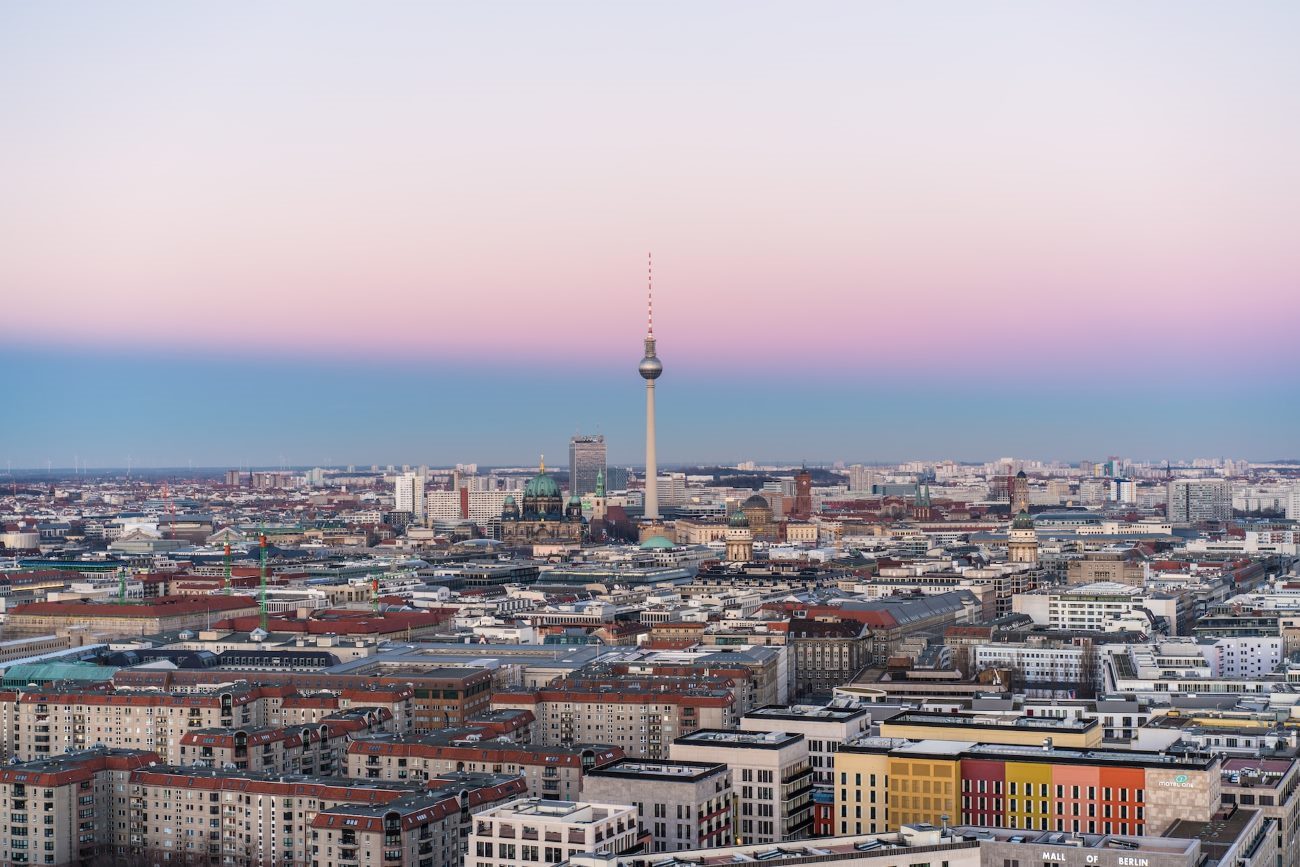
Duna Corso Budapest Sightseeing Boat: Explore the Beauty of Budapest from the Water
Budapest, the breathtaking capital of Hungary, is famous for its stunning architecture, rich history, and vibrant culture. One of the
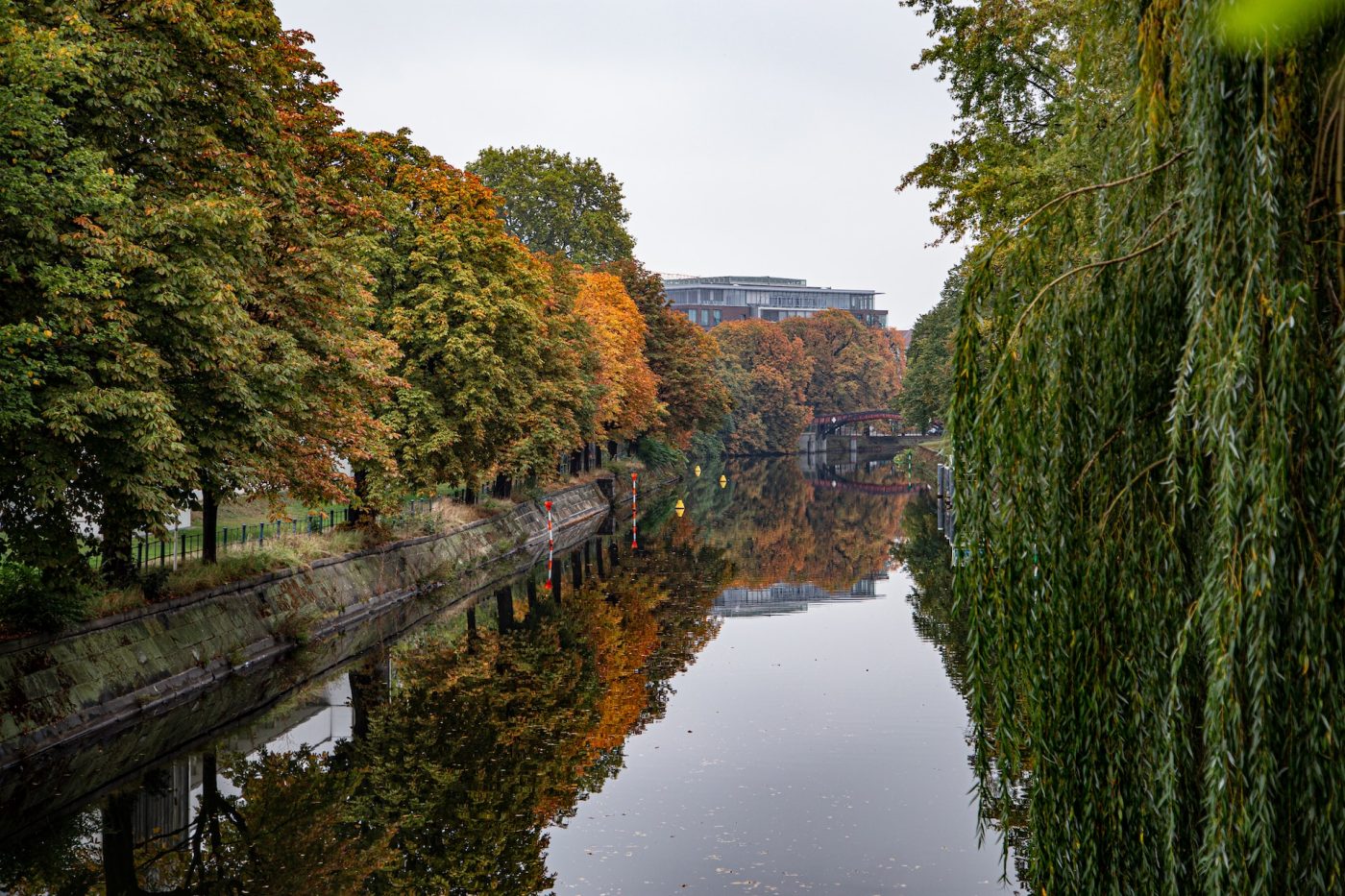
How Long Does it Take to Reach Sachsenhausen from Berlin?
If you are planning a trip to Berlin, Germany, you might be interested in exploring the nearby historical site of
Leave a Reply Cancel reply
Your email address will not be published. Required fields are marked *
Save my name, email, and website in this browser for the next time I comment.

The Budapest Travelcard

In terms of public transit coverage and ease of use, Budapest takes the cake. It was delightfully simple to get around the city and navigate buses , trams , and metros . In the summer, there are also ferries shuttling tourists and locals alike across the Danube River.
If you’ll be in Budapest for a full day or longer, we highly recommend buying the Travelcard.
A single fare on public transport costs 350 HUF, which is about $1.25. Cheap! However, we were moving around so frequently that we quickly saved money by purchasing a Travelcard.
Travelcard Prices
24-hour Travelcard: 1,650 HUF ($5.80)
72-hour Travelcard: 4,150 HUF ($14.80)
24-hour Group Travelcard: 3,300 HUF ($11.70)
7 Day Travelcard: 4,950 HUF ($17.70)
If you’re in a group of 3 or more, the group Travelcard is a great deal. Each group card can be used for up to 5 people. The only downfall is that you’ll have to buy a new 24 hour card each day of the trip.
If you’ll be in Budapest more than 3 days, the 7 Day pass is a fantastic deal!
Where to Buy a Travelcard in Budapest
We purchased our Travelcards at a customer service desk in the airport. There are also customer service centers at several of the popular metro stations in the heart of the city- Deák Ferenc tér, Keleti pályaudvar (which also houses the Keleti Train Station), and Móricz Zsigmond körtér, to name a few. You may also purchase a Travelcard from an automated kiosk available at many metro and bus stations. Use www.bkk.hu/salespoints to help find a location near you.
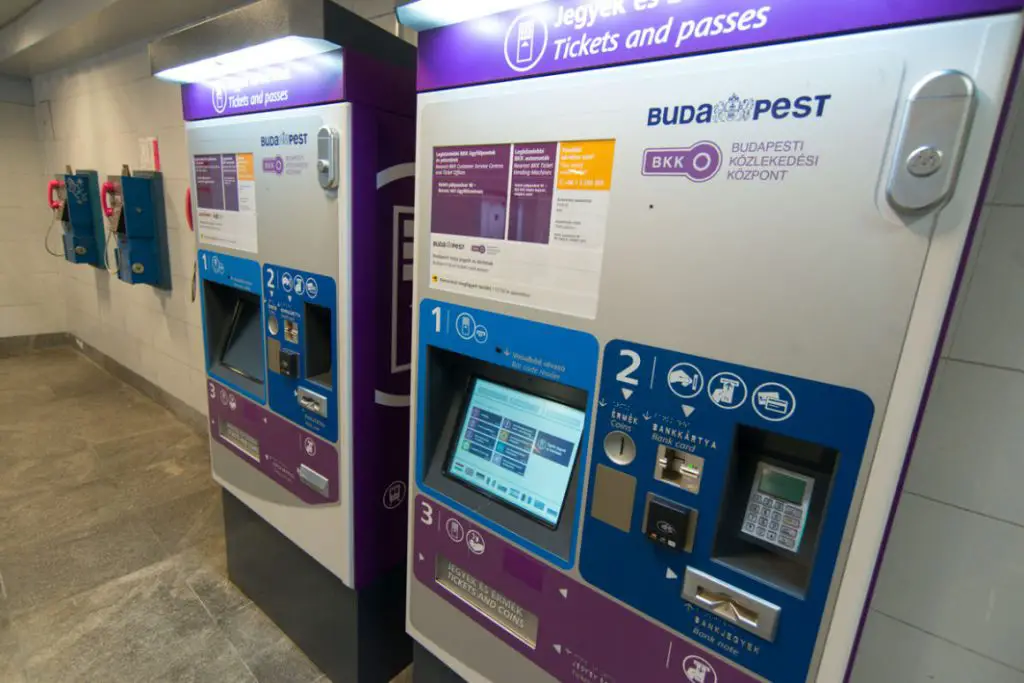
Caveats to the Budapest Travelcard
The uber-useful Travelcard does have a few limitations. It is not valid on the 100E airport bus, the funicular near the castle, and special Heritage Transport Vehicles. The Heritage Transport lines only run from May to October during the weekends, and are obviously marked. The Travelcard is available on boats during weekdays. On the weekend, you must buy a separate ticket for all boat routes except D14.
Using the Budapest Travelcard
Getting around Budapest is simple. We typically use Google Maps to determine which routes to use. For more info on how we do this, click here.
You will see plenty of signs reminding you to validate your ticket. However, if you hold a Travelcard, you do NOT need to validate your ticket each time you board. Instead, your card will be validated upon the start time you chose when you make the purchase, and will expire after the designated 24 or 72 hours.
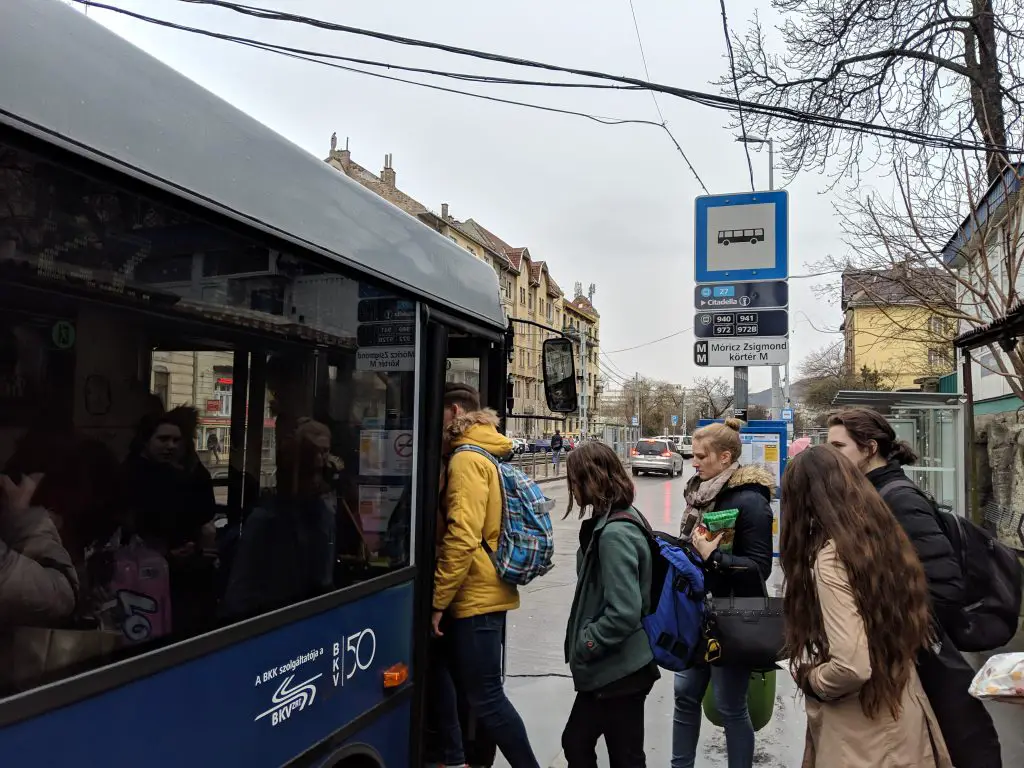
Other than these minor rules, the Travelcard will give you the ability to see any popular destination in Budapest. It’s a great value, and navigating the public transit system is simple! We would strongly recommend getting one of these passes as soon as you arrive in Budapest.
The Budapest Travelcard is NOT the Budapest Citycard!
The Budapest Card should not be confused with the Travelcard. The City Card can also be used for the same free use of public transportation. It also provides entry to several museums and guided walking tours. We did not find the Budapest City Card to be useful to us, as it is much more expensive (About $50 per person for 72 hours, which is an additional $35) and we were not planning on making use of many of its perks. We would recommend checking out their website and deciding if your travel plans would make use of the added features.
Click here to return to our Budapest Public Transit Main Page.
Related posts:
- The Overnight Train from Budapest to Warsaw
- Using Public Transportation in Budapest
- Getting to Budapest from the Airport by Public Transit
- Using the Metro in Budapest
Leave a Comment X
You must be logged in to post a comment.

OnlineTravelCardV2
Budapest travel card, what's included.

- Receive the card directly in your hand.
- No need to waste time picking up the card in Budapest.
- Valid for 72 hours for all metros, buses, and trams in Budapest.
- Your experienced driver will be waiting for you at the Arrival Hall with a sign bearing your name. This is the best way to start your city trip.
How it works

- The prices displayed are for accommodation within the city. If your hotel is outside the city, we will contact you with the appropriate pricing.
- Children under 12 years old travel for free on public transportation in Budapest.
- Click here to view the Public transportation information
At OnlineTravelCard.com, we are committed to providing you with a comprehensive travel solution that combines convenience, affordability, and personalized service. Elevate your Budapest experience with our Public Transportation Card and start your city exploration on the right foot.
Your journey begins here. Book your Budapest Travel Card now.
Reserve now and pay later
Easy Airport Transfers with Us
Our drivers are punctual and keep an eye on your flight schedule to ensure they're there when you need them.
Cancel Anytime for Free:
Plans change? No worries! You can cancel your booking without any charge.
Help Whenever You Need It:
Our customer support is available 24/7. Got questions or need assistance? We've got your back!
Travel stress-free with our reliable and flexible airport transfer service. Your journey, your way.
- Best Time to Visit
- Weather & Climate
- Budapest Airport Guide
- Public Transportation
- Neighborhoods to Know
- 72-Hour Itinerary
- Day Trips From Budapest
- Top Things to Do
- Free Things to Do
- Best Museums
- Thermal Baths
- Shopping in Budapest
- Hungarian Dishes to Try
- Best Restaurants in Budapest
- Ruin Bars to Visit
- Search Please fill out this field.
- Newsletters
- Destinations
Getting Around Budapest: Guide to Public Transportation
Although Budapest is a walkable city, it’s easy to get around thanks to its excellent public transport network operated by the BKK (Budapest Center of Transport) . If you’re not planning to go outside the Hungarian capital, it’s best not to rent a car as you’ll get around the city more quickly and easily with its extensive metro, tram, and bus system. This guide will help you prepare for your trip to Budapest, so you’ll be riding the subway and the tram like a local in no time.
How to Ride the Budapest Metro
Although buses and trams are the primary forms of transport in Budapest, the metro is the easiest way to get around the city for a first-timer. It is also the quickest way to get around the city. There are currently four metro lines, so it’s simple to navigate the city. Not to mention, metro line 1 is the oldest subway in continental Europe and a UNESCO World Heritage Site.
- Fares: Single tickets cost 350 Hungarian forints and you can change metro lines with a single ticket. Travel passes are also available for 24 hours (1,650 forints), 72 hours (4,150 forints), or a week (4,950 forints), which cover all modes of transportation. If you get a Budapest Card , you can have unlimited transport for the period you choose. If you have a single ticket, validate it in one of the validation boxes at the metro entrance—usually by the escalators—and keep it with you until the end of the journey.
- Routes and Hours: The metro runs daily from 4:30 a.m. to 11:30 p.m. from the first stop of each line, with trains coming every 2 to 5 minutes during the day and every 10 minutes during early morning and late evenings. There are four metro lines, line 1 (yellow) runs from Vörösmarty tér to Mexikói út. Line 2 (red) goes from Déli pályaudvar in Buda to Örs Vezér tere in Pest, and line 3 (blue) runs between Újpest-Központ and Kőbánya-Kispest on the Pest side of the river. Line 4 (green) is the newest and goes between the Kelenföld train station in Buda and the Keleti train station in Pest.
- Service Alerts: The metro, in general, is pretty reliable, but occasionally there are delays or closures, especially on metro line 3, which is undergoing renovation. Replacement buses run when the metro isn’t operational. You can check any updates at bkkinfo.hu or download the BKK app , which shows the estimated time for the next mode of transport.
- Accessibility: Metro line 4 is fully accessible, with elevators even running up to the platform. Line 1 is only accessible by stairs, line 3 has an elevator only at Kőbánya-Kispest station, and there are only three stations (Örs Vezér tere, Pillangó utca, and Puskás Ferenc stadion) that are fully accessible on line 2. You can read more about the accessible transport options on the BKK website.
Riding the Tram
Budapest’s tram network is extensive. More than 390 million passengers take the tram yearly, which is almost 100 million more than the metro.
- Routes: There are more than 30 routes operating on nearly 100 miles of track across Budapest. The most popular lines are the 4 and 6, which run along the Grand Boulevard, connecting Buda and Pest. Tram line 2 offers the most scenic route, as this takes you along the Pest embankment, with the 41 and 19 running parallel on the Buda side. The 47 and 49 trams operate on Small Boulevard to transport hub Deák Ferenc tér.
- Hours: Trams generally run between 4:30 a.m. and 12:30 a.m. from the end of the line. The tram line 6 runs 24 hours a day, every day.
- Fares: Fares for the tram are the same as for the metro. You will need to validate your ticket on board. Modern trams punch the ticket automatically. On older trams you will need to put the ticket in the validation box and pull the slot you put the ticket in hard to punch the ticket. Random ticket inspections are common, and if you are caught without a valid ticket, you will be fined. You can only use one ticket on one tram, so if you change lines, you will need to use another ticket.
How to Pay for Budapest’s BKK Network
There are many ways to buy a ticket or a pass. You can get them at the ticket offices in most metro stations, some newsagents or post offices, or from ticket vending machines. You can take a look at the interactive BKK map , which gives you all the sales points in the city, but the easiest ways to buy a ticket are:
- At the ticket office: You can usually find a ticket office in most metro stations. You can pay with cash or card.
- From the BKK Ticket vending machine: Most tram or bus stops, and metro stations, will have a purple ticket machine where you can buy tickets and passes any time of day. These accept both card and cash (even notes, you will get the change back in coins). All machines have the option to switch to an English language version.
- From the bus driver: If you need to take a bus, you can buy tickets directly from the driver (tickets cost 450 forints), and you must pay in cash.
- Via the Mobiljegy app: You can buy passes on the BKK mobile ticket app. You can read more about how this works on their website .
There are different bus services operating within Budapest. There are the standard blue buses and the red trolleybuses, which use overhead cables. While buses cross the city center, they are also best way to reach neighborhoods further into the suburbs, like the Buda Hills. Some buses require you to board at the front and show your ticket or pass to the driver. There are night bus services that run once the metro, tram, and regular buses shut down for the night.
BHÉV Suburban Train
There is a suburban train network, called the BHÉV, which takes you to the outer limits of the city and beyond. Most visitors will take the BHÉV to the town of Szentendre for the day. Your tickets and passes are valid on these within the city limits. However, if you are planning to go beyond, you’ll need an extension ticket you can buy from the ticket offices or the purple machines.
Airport Bus
The 100E airport bus offers a direct link to the city center, running between the airport to Kálvin tér and Deák Ferenc tér, and takes 40 minutes. Buses run every 10 to 20 minutes from 3:40 a.m. to 12:40 a.m. Single tickets cost 900 forints.
If you need a taxi, there are plenty of options. Never hail a cab from the street, as many companies are looking to scam foreign visitors, but call a reputable company like Főtaxi , City Tax i, or 6X6 . Alternatively, you can also download the Bolt app and order a cab that way (if you’re used to Uber, Bolt operates more or less the same way).
Anyone can use this bike-sharing system. Just walk around the city and look out for the lime green BuBi bikes . They can be rented for 24 hours, 72 hours, seven days, or get longer-term passes. Once you’ve got your time ticket, you can use the bike for free for the first 30 minutes, after which you’ll be charged an additional 500 forints for every 30 minutes used. You can buy the tickets using a bank card from the touchscreen terminals at the docking station, or on the website . There is a deposit of 25,000 forints, which is returned when you return the bike.
The BKK Boat
The best way to see Budapest is to go by boat, and if you’re on a budget, you can take the BKK boat service for a couple of dollars. Tickets on the boat cost 750 forints one way, and in the summer, some of the boat lines run from Kopaszi Gát to Római Part. In the winter, there are fewer services and shorter routes. You can see more about the boat services on the BKK website.
Tips for Getting Around Budapest
Transport in Budapest is affordable and convenient, but you can make life a little easier by following a few tips.
- Validate and keep your ticket. If you are not using a pass, make sure you validate the ticket and keep it on you at all times. Sometimes plain clothes inspectors get on the tram or bus to check at random, and it’s also possible inspectors check tickets as you leave the metro. Getting caught without a valid ticket means a hefty fine and an unpleasant encounter that ruins your trip.
- Don’t travel at rush hour. The tram, metro, and bus buses can get pretty packed between 8 and 9 a.m., and between 5:30 p.m. and 7 p.m. Try to avoid traveling during those times if possible.
- Keep an eye on your belongings. Budapest is generally a safe city, but like any capital, you have a risk of pickpockets. It’s possible to put your phone in your pocket for 30 seconds only to find it gone when you reach back in.
- Download the BKK App. The BKK Futár app will tell you when all modes of transport run to real time, and it can make it so much easier to plan your trip.
- Use Bolt if you need a taxi. Bolt is so easy to use, especially if you’re worried about the language barrier or getting taken advantage of. You can see your route in live time, get fare estimates, and see where your driver is while you wait.
Related Articles
More related articles.
Budapestbylocals.com
Budapest metro, 4 lines connecting buda and pest.
The city currently has 4 metro lines . The new line, M4/green line started operation in spring 2014.

The Budapest metro system is easy to use and you can get to anywhere in the city fairly quickly.
Provided there’s no maintenance or some emergency situation.
Small fires are quite frequent on M3/blue line in recent years due to which the line has to cease operation for a couple of hours.
The three main lines, M1, M2, M3 converge at Deák tér station in the city centre.
Here can change for any of the two other lines or continue your travel by bus, tram or since it is downtown Budapest you can conveniently explore the area by walk.
Table of Contents – Budapest Metro
Tickets/passes for the metro:.

You have to validate a single ticket (350 HUF) at orange automated machines before you descend the escalator to the metro train.
If you change lines at Deák tér you have to validate another ticket, unless you have a metro transfer ticket (530 HUF).
With a Budapest card, 24-hour, or 7 day travel card you can travel on all 4 metro lines/change lines or change for other public transportation unlimited number of times within the validity period of the pass/card.
TIP: Free Travel with the City Card
With a Budapest card you can travel on the city’s public transport services free of charge.
The card also entitles you to discount admission to a wide range off sights and attractions in Budapest (museums, baths, monuments etc.).
For a 2-3 day or longer visit it’s worth buying.
You have a choice to purchase a 24-hour, a 48-hour, a 72-hour, a 96-hour and a 120-hour Card
There is also a 72-Hour Card for Children 6 – 18 years old.
Buy the Card Online
M1 or millennium underground (yellow line).
- Vörösmarty tér
- Deák Ferenc tér
- Bajcsy-Zsilinszky út
- Kodály körönd
- Széchenyi Fürdő
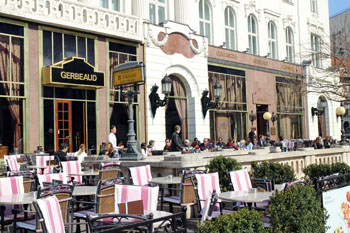
The Millennium Underground (M1, yellow line) runs between Vörösmarty tér (Budapest’s city center) and Mexikói út, connecting the city centre with Budapest City Park.
Built at the end of the 19th century M1 was the first underground electric train line on the European Continent (the second in the world after London).
Most station entrances and the notices on the walls are copies of the originals.
In the 1970s trains were replaced by modern ones.
Unfortunately you won’t find yellow M1 signs.
Look for signs saying “földalatti” (underground in English), like the one right in front of the Gerbeaud Confectionery on Vörösmarty tér .
Do take a ride on this historic line that is and enjoy the unique 19th-century atmosphere!
M2 (Red Line)
Déli pályaudvar (southern railway station) – örs vezér tér.
(Look for red M2 signs!)
- Déli Pályaudvar
- Széll Kálmán tér
- Batthyány tér
- Kossuth Lajos tér
- Blaha Lujza tér
- Keleti Pályaudvar
- Puskás Ferenc Stadion
- Pillangó utca
- Örs vezér tere
The Eastern Railway Station (Keleti Pályaudvar) is also on this line. Kossuth Lajos Square where the Parliament stands is also on this line.
M3 (Blue Line)
Note: M3 metro is under construction so please check the BKK website (Public Transport Company of Budapest) for up to date information on schedule and replacement bus services.
Újpest városközpont (northern part of the city, district IV.)- Kőbánya, Kispest (industrial district)
(Look for blue M3 signs!) :
- Újpest városközpont
- Újpest várokapu
- Gyöngyösi utca
- Dózsa György út
- Nyugati pályaudvar
- Arany János utca
- Ferenciek tere
- Corvin-negyed
- Nagyvárad tér
- Pöttyös utca
- Kőbánya-Kispest
The Western Railway Station (Nyugati Pályaudvar) is on this line.
Bus 200E line connects Liszt Ferenc Airport with Kőbánya-Kipest termini, an economic way to get to the centre from the airport .
M4 (Green Line)
Keleti railway station (keleti pályaudvar) – kelenföld railway station (kelenföld pályaudvar).
(Look for green M4 signs!):
- II. János Pál pápa tér
- Rákóczi tér
- Szent Gellért tér
- Móricz Zsigmond körtér
- Újbuda központ
- Kelenföldi pályaudvar
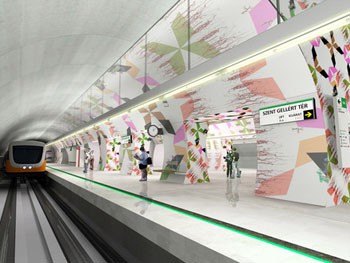
The 4th subway line started carrying passengers at 28. March 2014 after the successful test runs.
The 7,3 km long new line connects two main train stations
- Kelenföld in West Buda and
- Keleti Station in the eastern part of the city centre) with interchange points to the other two metro lines and above-ground travel services
The line crosses the Danube at Gellért tér station.
- Gellért Spa – a historic thermal bath and 4-star hotel, and
- the Gellért Hill with the Citadel and the Liberty Statue
are the two main attractions here), next comes Fővám tér, where you can get off to the Great Market Hall (Nagyvásárcsarnok).
The state-of-the-art metro trains run completely on autopilot .
The 10 stations are also new attractions in the city with unique, 21-st century architecture including a bit of Budapest or Hungary trivia in the design and decor.
See more on M4 metro on the official website.
Metro Tickets:
- Single ticket, 350 HUF – valid on metro, bus, tram, trolleybus, cogwheel tram, on the whole length of the line for one uninterrupted trip. On suburban railway (HÉV) it is valid within the administrative boundaries of Budapest.
- Transfer ticket, 530 HUF – if you need to change lines or use tram, bus, trolley or other public transport service. Read more about it here .
- Short section metro ticket for up to 3 stops, 300 HUF – valid only on the 4 metro lines for up to 3 stops on a single line (no change for another line is included).[
See more information on public transport ticket and other transport services in Budapest.
Metro Map with the New M4 Line (Green)

See metro timetables at the Budapest Public Transport Company’s (BKK) website.

Public Transport
Budapest metro.
The Budapest metro has four lines and is easy to use , as three of them only cross in one point: Deák Ferenc tér station
Budapest Metro has four lines and is relatively easy to use . Three of the four metro lines intersect only once, at Deák Ferenc Square.
Tips to keep in mind before using the Budapest Metro:
- You must validate your ticket in any of the transport company’s orange validating machines before you get on the metro.
- A single ticket is only valid for a one-way uninterrupted ride . This means that you may not change lines. You should validate another single ticket if you need to take another metro line. Moreover, a one-journey is valid for 80 minutes (120 minutes at night-time).
Information on the various lines and most significant metro stations:
Line 1 (yellow line)
Line 1 runs from Vörösmarty tér to Mexikói út. This line stops at numerous landmarks and museums, making it very useful for tourists.
It runs through Andrássy Avenue and stops at the Hungarian State Opera House , the Oktogon Intersection, Heroes’ Square and City Park . It also stops very near the Chain Bridge .
The Metro line 1 is one of the easiest lines to take since it is not very deep and; therefore, you will not have to walk down many stairs. In addition, its stations are curiously decorated.
Line 2 (red line)
It crosses Budapest from Buda’s Déli Pályaudvar (Déli Railway Station) to Pest’s Örs vezér Square. The most useful stations for tourists are Kossuth Square, where the Hungarian Parliament is located, Batthyány Square, which is the Fisherman’s Bastion metro stop and Astoria , the closest station to the Great Synagogue .
Line 3 (blue line)
You will find this route useful if you take the bus 200E from the Airport to the city centre . The bus's final destination is Köbánya-Kispest, which is the first Line 3 metro station.
Line 3 also stops at the Great Market Hall (Kálvin Tér).
Line 4 (green line)
Opened in 2014, the metro line 4 runs for 4 miles (7 kilometres). It connects the two main railway stations in the city : Keleti Railway Station and Kelenföld Railway Station.
Budapest Metro opens every day at 4:30 am and runs until 11 pm . The trains pass every 2 to 15 minutes depending on the time of day.
BKK, Budapest's public transport company issues the same tickets and travel passes for all of the city's transport system. Moreover, transport in Hungary's capital always costs the same. Check out the following article for more information on the transport tickets and passes:
- Budapest transport ticket and pass prices.
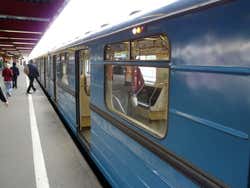
You may also be interested in
Budapest can claim to have a rather efficient system of public transport, buses, trolleybuses, trams and metros all more than do the job with regards to punctuality and frequency.
Budapest has over 40 tram lines that run throughout the historic center. Read about the most important lines, schedules and tickets.
Guide,tips and tricks for Budapest travelers
Is Budapest Card worth it in 2024?

In 2024,one of the convenient ways to use Budapest public transport is by getting public transport passes. These are also called Budapest transport pass as well as Budapest travel card.
These passes can be used on any transport vehicle, either buses, trams,trains and underground metros.(aside from Budapest Airport Shuttle ,i.e.100E, and some legacy trams which operate only during summer season)
Budapest single and multiple day travel passes provide a hassle free way for tourists to use public transport of Budapest within a certain time limit. You should definitely bring comfortable shoes and light weight backpack or trolley bag if you plan to use Budapest public transport in Budapest.
If you are looking for light weight and durable luggage, check out the latest collection from Horizn-Studio and get a 20% flat discount with code HSxBudapezt .
If you are looking for shopping at Vaci Street in Budapest and plan to stay in historic 5 star hotels nearby, do check the following.
- Emareld Hotel
- Parisi Udvar
- InterContinental Hotel
- Korona Mercury Hotel
You can get on board and get off from any bus, trolley or underground metro, depending upon what pass you have bought.
On the other hand, Budapest taxis are hardly required if you are in the city center.
Budapest public transport passes are different from the single tickets and transfer tickets,which can be used only for single journeys.
Table of Contents
Budapest transport pass types
If you are visiting Budapest for 1 to 7 days, buying a transport pass will be a better option compared to buying multiple single tickets,block of 10-tickets or transfer tickets.
Especially, if your plan is to explore the attractions in Budapest with frequent changes in transport routes and without using hop-on-hop off buses. You should definitely consider buying Budapest transport pass.
From the BKK ticket machines and online pass buying options in Budapest public transport app , there are multiple Budapest transport passes available.
However, for majority of Budapest visitors, the optimum Budapest travel passes are the following,which are way cheaper compared to Budapest Cards (Instead getting a Hop on hop off tour is still better). Keep in mind that there is no discount for any monument entry if you are buying any of the following Budapest travel passes.
- Budapest day travel pass
- Budapest 3 day travel pass
- Budapest-24-hour-group-travelcard

Here are the details of available passes and card in Budapest with prices.
Budapest travel pass vs Budapest card
It is important to know the difference between Budapest travel pass and Budapest card as both have different prices and benefits.
Both the Budapest travel pass/card and Budapest card have different appearance, although both are available for one to multiple days time limit.
Budapest card is specially designed for tourist. Budapest card will allow you to have unlimited journey within Budapest,and also allow you to visit many Budapest monuments with a discount.
With Budapest Card,you can explore major attractions via public transport for free and get entry to multiple monuments with discounts.You can purchase it here .
Budapest travel pass/Budapest travel card
Budapest travel pass allows you to use the public transport of Budapest for unlimited rides within the allowed time limit(24 hours/1 day,72 hours/3 days,168 hours/1 week) on your card.
With Budapest travel pass, you can use all the vehicles operated by BKK, Budapest night buses,Metros M1,M2,M3,M4, Trams 2,47,48,49 and many more. Check BudapestGO app for all the available vehicles operated by BKK. However, Budapest travel pass does not give any additional benefits in terms of entry to any paid monument.
Keep in mind that, you cannot use any Budapest travel pass/Budapest travel card or Budapest Card for on boarding 100E bus.

Budapest Card
With a Budapest card,you can use unlimited rides on buses,trolleys,and metros within the time limit on the card.In addition, the Budapest Card will get you discounts when buying entry tickets for paid attractions in Budapest.
It is important to know the key difference is that in Budapest Card, there is no travel word.The Budapest card design is more fancy.
It is more expensive and you cannot buy it from BudapestGO app or BKK machines.
You can explore Budapest by your own with a Budapest Card,which allows you to use Public transport for free. Click here for buy it online .
Budapest day travel pass 2024
It is essential to know that the official name of Budapest day travel pass is “24-hour Budapest-travelcard”.
The name is the same whether you buy from the BKK machines or the BudapestGO app.
Budapest day travel passes can be called with many names.
If you are searching for any of these terms, then these belong to the same one day Budapest travel card.
- Budapest day pass
- Budapest one day travel card
- Budapest metro day pass
- Budapest one day pass
- Budapest 24 hour pass
- Budapest 24h ticket
Budapest one day travel card benefits
In 2024, following are some benefits of using one day Budapest travel card .
- Perfect for a Budapest solo tours for self guided quick tour of the city.
- In printed format, you do not need to validate anywhere.
- Can be used in Budapest buses , Night bus Budapest , sightseeing Budapest trams and Budapest Budapest .
- Unlimited bus,tram,metro and trolley rides within Budapest city within the 24 hours of validated time,print on the card.
- Hassle free ride in Budapest public transport system compared to using tickets, and complex ways of validating them.
- You can get from Budapest airport to city center by using 200E+M3 metro.
Budapest one day travel card where to buy?
You can buy Budapest one day Budapest travel cards from the BKK machines installed on various bus,tram and metro stations.
One day travel cards for Budapest can also be purchased from the BKK offices at the Budapest Airport, Keleti Railway station and other major metro stations.
The third option is to buy a one day Budapest travel card from the BudapestGO app.
On the other hand Budapest Card can be booked online,while it has to be picked up in the Budapest from specific locations. For purchasing Budapest Card, check availability here.
We recommend that tourists should buy Budapest hop on hop off bus tickets , instead of getting a Budapest Card as it is very expansive and not worth the money.
Budapest one day travel pass Price
The cost of a Budapest one day travel pass is 2500 HUF.
The price for a day pass in Budapest in British pounds is around 5.5 GBP, while in dollars it is $6.7 USD and in Euros around 6.3 EUR.The price for a one day travel card is the same whether you buy from the BKK office, BKK machines or from the BudapestGO app.
Keep in mind that you can purchase a one day pass with a visa/master card at any of these locations,hence, no need for money exchange in Budapest .
This is because BKK ticket machines and BKK offices accept master/visa cards for payments.
Buying Budapest one day travel card online
You can purchase a Budapest one day travel card online with the BudapestGO app.
It is essential to note that you must create an account before online purchase of the one day card.
Also you need to activate the card before starting to use it, and this will require internet connection.
If your mobile does not have an internet connection, despite purchasing the card, it will be not a valid one and hence, you may be fined if caught without activating the card.
Budapest one day travel card Validity
As evident from the name, the validity of a one day travel card is exactly 24-hours from the starting time.
For a BKK ticket machine printed 24 hr Budapest travel card, the start time/date and finish time and date are printed on the card.
You can choose the card starting time on the BKK machine and it will automatically adjust the validity time on the printed paper card with details.
For a one day travel card for Budapest ,in printed form, bought from the BKK office, the validity time of the card may be written manually by the clerk in the office,instead of a printed date, and it should also be fine to use.
If you bought the Budapest one day travel card from BudapestGO app, you must ensure to activate it before using it. As it is in digital format, make sure to have internet, when you plan to use it.
Can you use Budapest one day travel card on 100E
Budapest one day travel cards cannot be used on 100E.
You have to buy a separate ticket costing 2200 HUF (6.5 USD/GBP/EUR)to board the 100E bus in one direction.
However, with a Budapest one day travel card,you can use the 200E bus Budapest from airport and then M3 metro from Kobanya kispest to reach the city center.
Can you buy Budapest day pass from airport
Yes, you can buy a Budapest one day pass from the airport after arriving from the BKK ticket office.
Also you can buy it from the ticket machines installed right next to the bus stop, 2 mins walk from the airport.
The ticket machines have multiple languages available to select.
Identification number for Budapest one day travel pass
When asked about a document number for a Budapest one day travel pass, you have to enter the number of any valid document,which contains your photo.
This could be your EU ID card, Passport, Driving license.
In case you are checked by ticket checkers, they will compare your id card number with the number on the one day pass.
Do you need to validate the Budapest one day pass
For a 24-hour Budapest pass bought from the BKK ticket machine or the BKK office, there is no need to validate it anywhere.
Unlike the Budapest public transport tickets ,and transfer ticket Budapest which have to be validated in machines in respective ways of transport(bus,tram,metro). Check How to validate ticket Budapest ?
You can just show the one day travel pass, if a ticket checker asks in the blue bus,trams,or trolleys during random check.
You may need to show it to the driver when on boarding a red bus, or to the ticket checkers when entering the escalators of underground metro.
Sometimes you may be checked when going out of the metro station,and showing a valid one day pass will let you come out of the metro station.
Vehicles not allowed with Budapest one day travel card
You cannot onboard Budapest 100E bus with a one day travel card. You will be fined if caught by ticket checkers.
Additionally, keep in mind that hop on hop off buses are also not allowed with the 24-hour travel card.
During the summer time,there is a retro tram which has a unique appearance and only operates around the city center.
This tram cannot be boarded with the 24 hour Budapest card.
Important vehicles with Budapest 24hr ticket
In 2024,All the famous monuments within the city of Budapest can be reached with public transportation covered by 24 hour Budapest pass.
M1,M2,M3, and M4 can take you to any famous monument within 30 mins, and these are covered in a 24 hr ticket.
You can explore the majority of the city with tram 6-4,47,48,49 also covered in the 24 hr ticket.
For exploring the river side of Budapest, tram 2,41 are covered in the 24 hour ticket.
All the buses from Keleti Railway station towards the city center are covered in a 24 hour Budapest pass.
On a weekday, some ferry rides operated by BKK are also covered by a 24 hour ticket,while on weekends it is not.
Bus 15 can take you to the castle district from the city center, also covered by a 24 hour ticket.
Budapest one day pass discounts
There is no such option to have a discount on Budapest 24 hour travel card as of 2024.
Either you are a student or belong to any other category, the price of 24 hour travel pass in Budapest is fixed,i.e. 2500 HUF.
Related Posts

200e bus Budapest 2024 | Budapest airport bus 200e

Bus 100E Budapest 2024 | Budapest Airport Bus 100e

Night Bus Budapest 2024 | Night transport in Budapest

Budapest airport shuttle to city centre
Privacy overview.
This website uses cookies to improve your browsing experience and analyze the use of the website. Learn More

Budapest Metro + Public Transportation

The city of Budapest has a rather extensive and useful public transit system known as BKK which includes the metro, tram, trolleys, buses, and even suburban trains (known as HEV lines).
This post will help you navigate each of the public transportation services in Budapest in addition to offering advice for saving money on tickets.
TICKETS AND DEALS
There are a few different ways to pay for admission to public transit in Budapest, and each option is valid on all vehicles including the metro, trams, trolleys, buses, and HEV trains.
The main method is simply to purchase a single ticket, which is good for one uninterrupted trip.
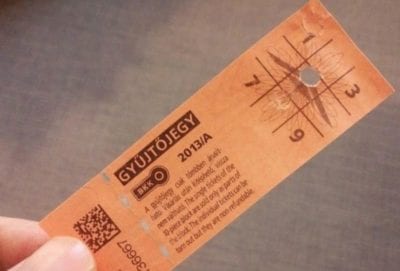
There are also transfer tickets you can buy which allow you to move from one mode of transport to another.
There are several additional ticket options to choose from including metro section tickets and blocks of 10 tickets, but these are intended more for locals than travelers.
- Single Ticket: €1 (€1.25 if purchased onboard)
- Single Transfer Ticket: €1.50
- Metro Section Ticket: €0.85
- Block of 10 Tickets: €8.50
Learn more about these ticket types .
Alternatively, you could save avoid the potential hassle of figuring out the # and type of tickets you need and by purchasing a travel card instead.
There are 3 different versions of travel cards available in Budapest: 24-hour, 72-hour, and 7-day.
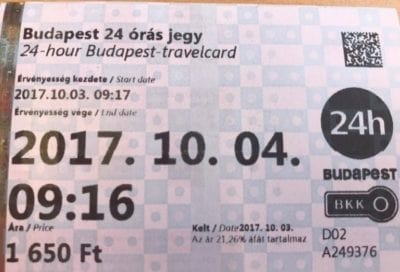
The 24-hour card can be purchased either for individual riders or for groups of up to 5 people.
The 72-hour and 7-day cards are only available for individual riders.
Each travel card is valid on all public transport network vehicles, so you won’t need any other tickets to climb on board.
These cards become valid the moment you purchase them, so we recommend that you don’t pick one up until you need it.
In other words, if you get the pass at 9 pm, it will only be valid until 9 pm the next day.
- 24-Hour Travel Card: €4.65
- Valid for up to 5 people (€1.87 per person)
- Price per day: €3.92
- Price per day: €2
How do I pay for public transport in Budapest?
Tickets and passes can be purchased either at ticket vending machines or newspaper kiosks.
Most ticket offices have closed down in favor of the ticket vending machine, but occasionally you’ll find one at metro stations in the city.

You can also purchase tickets onboard buses for an additional fee.
Ticket inspectors randomly come aboard to check and make sure everyone has paid their fare, with fines up to €45, so be sure to validate your tickets.
Another option is to purchase a tourist pass known as the Budapest Card .
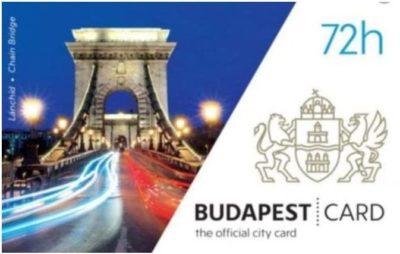
This service provides free public transport for the amount of time it is valid (1-5 days).
- 1-Day Budapest Card: €21.99
- Price per day: €16.49
- Price per day: €14.33
- Price per day: €13.25
- Price per day: €12.60
At first glance, the tourist pass may look a bit more expensive, but when you consider the fact that it also includes admission to dozens of popular attractions for free , the price makes more sense.
Additionally, you can also save up to 50% off many popular tours, landmarks, museums, amusement parks, and more.
Depending on how you use this concession pass, you could potentially save more money on public transport by using a Budapest Card instead of a travel card.
Another nice thing about this tourist pass is that it only becomes valid when you activate it, so you can purchase it ahead of time.
For more details on this service, please read our post covering Budapest tourist passes .
BUDAPEST METRO
There are currently 4 metro lines in Budapest that provide service to the city centre and some of the outskirts of the city.
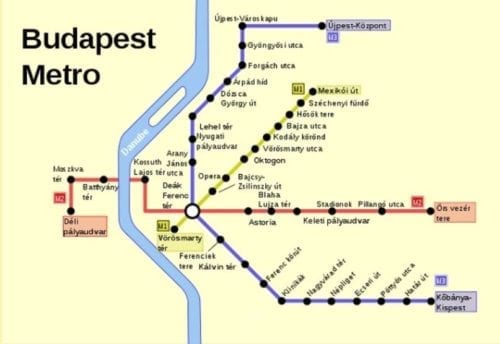
There are several stops that would be of interest to travelers and tourists.
Line 1 | Yellow Line
- Runs from Vörösmarty tér to Mexikói út.
- Includes stops at the Hungarian State Opera House, Heroes Square, City Park, and the Chain Bridge.
Line 2 | Red Line
- Runs from Buda’s Déli Pályaudvar to Pest’s Örs vezér Square.
- Includes stops at the Hungarian Parliament, Kossuth Square, Batthyány Square, and the Great Synagogue.
Line 3 | Blue Line
- Runs from Újpest városközpont to Kőbánya, Kispest.
- Includes a stop at the Great Market Hall, St. Stephen’s Cathedral, the Hungarian National Museum, and more.
- Connects with bus 200E (airport transfer).
Line 4 | Green Line
- Runs from Keleti Train Station to Kelenföld Train Station.
- Includes stops at Bikás Park, the Gellért Thermal Baths, the Hungarian National Museum, the Great Market Hall, and more.
The metro opens every day at 4:30 am and runs until 23:00 (11 pm) at night.
You can expect metro trains to make stops every 2-15 minutes on average depending on the time of day.
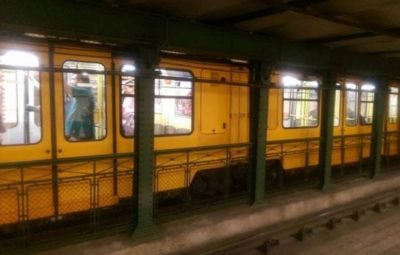
You’ll find ticket machines at most metro stations, and there are also ticket offices at a few locations as well.
Before boarding, you must validate your ticket at one of the orange machines you’ll find at each station.
There are more than 40 different tram lines in Budapest, and you can distinguish them from the metro by their yellow color.

While all the lines on this tram network are helpful for locals, tourists will find the following services most useful.
- Includes stops at the Hungarian Academy of Sciences, the House of Parliament, St. Gellert’s Hill, Buda Castle and more.
- Includes stops near the Buda Castle, Citadel, House of Parliament, Rákóczi Square Market Hall, and more.
- Tram 6 operates all night long .
- Includes stops near or at St. Anne’s Church, Gellért Hill, Gellért Spa, Citadella, Batthyány Square, and more.
- Includes stops at the Hungarian National Museum, the Great Market Hall, the Liberty Bridge, Lake Feneketlen, and more.
- Includes stops at Bauhaus Street, Körszálló (the Round Hotel), an enchanting forest, Hűvösvölgy and more.
Much like the metro, Budapest’s trams provide a lot of great stops that travelers and tourists might want to see.
What sets this service apart from others is the greater accessibility and number of lines.
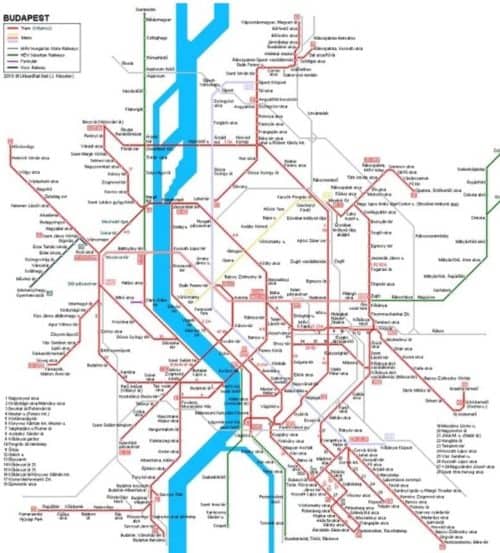
The Budapest trams run from 4:30 am to 11 pm each day, and the most popular lines run every 5-10 minutes on average.
Typically, this service is a bit slower than the metro – especially when it comes to the most popular line, Tram 2 – but you probably won’t have to wait an excessively long time.
Every major tram stop will have a ticket machine nearby which you can use to purchase admission.
Once you step on the tram, you’ll need to validate your ticket using the red, yellow or orange ticket validators on board.
There are over 250 bus lines in Budapest, which makes them one of the most difficult aspects of the public transit system to navigate.
That said, there are some reasons you may want to consider using the bus in this city, and a few great lines that are useful for travelers and tourists alike.
- Connects the airport with the Kőbánya-Kispest metro station.
- Connects Keleti Pályaudvar with Móricz Zsigmond Körtér.
- Includes stops at Blaha Lujza tér, Astoria, Ferenciek tere, Rudas Bath, Hotel Gellért and more.
- Connections with trams 4, 6, and the red, blue, and green metro lines.
- Connects Deák tér with Széll Kálmán tér.
- Includes stops at or near the Buda Castle Funicular, Buda Castle, Parade Square, Matthias Church and more.
- Connections with all metro lines at Deák tér.
- Connects Gyöngyösi utca with Apor Vilmos tér.
- Includes stops at Heroes Square, the Chain Bridge, as well as additional locations along Andrássy Avenue.
- Offers service all night long at stops marked with owl symbols.
Although there are a lot of blue buses that service popular stops in Budapest, there are just as many trams and metro trains that visit the same locations, so you may find that you won’t need to use the bus in this city.
That said, the airport transfer via bus 200E is definitely useful, and it’s unquestionably one of the most affordable ways to reach the city center – especially if you use a travel card or tourist pass.
There is also a 100E bus which is more of a shuttle bus, offering a direct transfer to the city center from Terminal 2.
This line also has more space for luggage, making it ideal for travelers.
This line costs around €2.70 for a ticket as opposed to the €1 fare on the 200E line, but there are fewer stops on the way to the city, and the bus is literally designed for airport transfers, so it’s definitely worth consideration.
It’s also nice that buses 900-999 provide service during the hours that other public transit options are usually not running (from 11 pm - 4:30 am).
In addition to that, the buses are one of the best ways to reach areas like the Buda Hills. If you need to reach the suburbs, consider this Budapest transport option.
Tickets can be purchased on board, but you’ll pay €0.25 more for the convenience.
If you’d rather save some money, you can use a ticket machine, visit a post office, a travel card, or a concession pass .
In addition to all the traditional buses in Budapest, there are also 15 red-colored trolley bus lines in the city numbered 70-83.
Each trolley connects with either the metro or trams at several locations throughout the city, making this an excellent alternative for transfers to other services in Budapest’s public transit system.
Here are a few details to keep in mind about each trolley:
- Includes stops at Transport Museum, Andrássy Avenue, Kossuth Square, and more.
- Connects with trams 2, 4, and 6, as well as lines 1 and 2 of the metro.
- Includes stops at Andrássy Avenue, Kossuth Square, Bethlen Gábor Square, and more.
- Includes stops at Kálvária Square, Gypsy Musician Park, Kalvin Square, and more.
- Connects with trams 2, 4, 6, 47, 49, and metro line 4.
As with all other forms of public transportation in Budapest, you’ll need to purchase tickets either from a ticket machine or in the form of a travel card or tourist pass.
Much like the trams and metro, these red trolleybuses run from about 4:30 am - 11 pm, give or take a half-hour depending on which line you choose.
Otherwise known as suburban trains, this railway system is designed more for locals than for travelers and tourists, but there are some lines you might want to consider.
The Szentendre train (Line 5) runs from Batthyány tér to Szentendre, a small town on the bank of the Danube River that gives you a taste of Hungarian living.
This line also includes a stop at Aquincum, an ancient Roman city in Budapest that you might want to visit in order to see some of the ruins and historic architecture in the area.
Another great option is the line that runs from Örs Vezér tere to Gödöllo (Line 8), as Gödöllo is a popular little baroque village that houses the royal Gödöllo Palace and was one of Queen Elizabeth’s favorite residences.
Although these services can be helpful for anyone planning to take short day trips outside of Budapest, it’s important to note that anyone leaving the city center on an HÉV train will need an extension ticket.
These ticket prices depend on how far out you’ll be going. Here are the fares you can expect to pay:
- 10 Km Extension Ticket: €0.70
- 15 Km Extension Ticket: €0.85
- 20 Km Extension Ticket: €1.05
- 25 Km Extension Ticket: €1.30
- 30 Km Extension Ticket: €1.60
As you can see, even though you might have to pay a bit extra to use the HEV trains outside of the city, the prices are quite reasonable and definitely worth consideration.
HÉV suburban railway trains run once every 10-30 minutes depending on the line and the time of day, and they provide service from 4:30 am - 12 am each day.
BOATS AND FUNICULARS
In addition to the metro, trams, buses, trolleys, and HEV trains, there are also a few public boats you can use in Budapest, as well as one funicular you might want to consider.
The public boat lines are provided along the Danube River between Boráros tér and Római fürdő from March to October. Here are the lines currently available:
- D11 | Haller utca - Újpest Árpád út
- D12 | Haller utca - Római Fürdő/Lido
- D13 | Haller utca - Római Fürdő
- D14 | Csepel-Királyerdő - Soroksár Molnár-sziget
Tickets for the public boat service are €2.10 for adults and €1.55 for children, and you can purchase them on board.
Alternatively, you can also use either travel cards or tourist passes for unlimited access to these boats.
When it comes to funiculars, there’s really only one of note that most travelers will want to consider: the Buda Castle funicular from Clark Adam Square.
This service is not included with any public transport ticket, travel card, or tourist pass, so you’ll have to purchase admission separately.
Here are the ticket prices:
- One Way: €2.85/Adults | €1.70/Children
- Return: €4.85/Adults | €3.15/Children
The Buda Castle funicular runs from 7:30 am - 10 pm each day, and it can be found at the Buda end of the Chain Bridge.
MOL BUBI PUBLIC BIKES
In addition to all the other options on Budapest public transport (BKK), they also offer bike rentals for those who want a little more control over their transportation.
All you have to do is download the free MOL Bubi app and use it to unlock a bike at one of the 190 stations throughout Budapest.
The app also includes a map, making it easy to find the closest station.
One of the best things about the Bubi bikes is that they are available 24/7, so even when the buses and trains aren't running, you can always grab a bike and use it to get around.
Pricing Options
There are three different ways to pay for this service: pay-as-you-go, a monthly pass, and an annual pass.
Most tourists will probably stick to the pay-as-you-go option, as even the monthly pass is going to make more sense for locals.
Pay-As-You-Go
- 40 HUF (€0.10) per minute
- 2400 HUF (€6) per hour
- 4800 HUF (€12) for 2 hours
- 9600 HUF (€24) for 4 hours
Monthly Pass
- 1000 HUF (€2.70)
- The first 30 minutes are free
- 40 HUF (€0.10) per minute after
Annual Pass
- 8500 HUF (€23)
Due to the way the pricing is structured, it actually makes more sense to get a monthly pass if you plan to use Bubi bikes multiple times over several days, even if you're just visiting on vacation.
The monthly and annual pass options allow you to use a bike for 30 minutes for free, and all you have to do is return it to one of the many stations in time to avoid additional fees.
Once you've returned a bike, you can take out another one and restart the 30 minute timer.
If you're planning to do some sightseeing, this might be a good way to get from one attraction to the next, as most landmarks have a station nearby.
RELATED POSTS:
- Tourist Attraction Concession Passes
- Things to Do in Budapest
- Hop-On-Hop-Off Buses
Choose a Destination... I want them all PLUS general travel tips. Amsterdam Berlin Boston Charleston Chicago Dubai Lisbon London Los Angeles Miami Nashville New York City New Orleans Paris Philadelphia Prague Rome San Francisco Washington DC
About The Author

Boglarka Bordas
North america, united kingdom & ireland, middle east & india, asia & oceania.
Public Transportation and Metro Rail Information
Budapest Metro
Budapest metro information.
The Budapest Metro is a rapid transit system and a popular means of public transportation in Budapest, Hungary. The system began operation in 1896 and is the second oldest in the world. It currently has 4 lines serving 52 stations. The total length of the network is 38.2 kilometres. It is also the oldest electrified metro system in Europe. It is operated by Budapest Transport Centre (BKK) and Budapest Transport Plc.(BKV). According to 2011 statistics, the metro had a daily ridership of 1.27 million passengers and an annual ridership of 463.6 million passengers.
The Budapest Metro is a prominent transport system in the city, serving a significant number of passengers, approximately 1,270,000 per day. In 2009, the fare for a single journey was €0.95 and it operates on an honour system.
The metro does not operate 24 hours a day and has no air conditioning. In addition, passengers cannot walk between platforms and the trains are not driverless. There are no screen doors on the platforms.
Budapest Metro is operated by BKV. Operating hours are from 4:30 to 23:30 every day of the week. The fare is 350 Hungarian forints (HUF).
For more information about the Budapest Metro, you can visit the official website at http://www.bkk.hu/en/ or contact them at +36 1 3 255 255.
Budapest Metro Map
Map of Budapest Metro showing different lines and stations. Click on the map to enlarge it or download the Budapest Metro map in PDF format .

Interactive Map of Budapest Metro
Tickets and prices
- Single tickets: These cost 350 Ft and allow travel on the entire length of a line. There’s no time limit on travel.
- Transfer ticket: This ticket costs 530 Ft and allows a single trip with one change between lines.
- Short distance metro ticket: It costs 300 Ft and is valid for up to three stops without changing.
- Single ticket bought on the spot: It costs 450 Ft if bought from the driver on board the vehicle.
- Block of 10 tickets: This costs 3,000 Ft and is convenient for travellers making frequent trips in a short time.
- Budapest Card: This offers unlimited travel on all transport networks, free or discounted entry to many attractions and costs between Ft6,490 (24 hours) and Ft15,990 (72 hours).
- Travelcards: These allow unlimited travel for a specified period and are available for 24 hours (1,650 Ft), 72 hours (4,150 Ft), 7 days (4,950 Ft), 1 month (9,500 Ft) and 1 year (115,000 Ft).
- Discounted monthly Budapest pass: For students and pensioners there is a discounted rate, these passes cost 3,450 Ft.
- Group ticket: For 5 people travelling together, this ticket costs 3,300 Ft and is valid for 24 hours.
Schedule, Timetables, and Calendar
The Budapest metro runs between 4.30am and 11.30pm. Trains arrive every 2-15 minutes, depending on the line and time of day.
Rules and Regulations
The following rules apply in the Budapest Metro
- Smoking is not allowed in any part of the underground.
- Bicycles are allowed only on weekends and public holidays, and only on lines M1, M2 and M4. On weekdays, bicycles are not allowed at peak times.
- Animals are allowed, but dogs must be on a lead, muzzled and have a valid ticket. Small pets must be in a sealed container.
- Alcohol is not allowed on the underground.
Tickets must be validated at the orange boxes before travelling. If you are caught without a valid ticket, you can be fined up to 16,000 Ft.
Facilities and Services
All metro stations have digital displays showing the time remaining until the next train. Some stations have lifts for wheelchair users and most have escalators. Stations are monitored by CCTV cameras and there are regular patrols by the police.
Keep your ticket until you have finished your journey as you may need to show it to a ticket inspector. There are regular checks and fines for not having a valid ticket.
Make sure you validate your ticket. Tickets must be validated at the orange machines located at the entrances to metro stations, trams and buses.
Plan your journey in advance. Knowing your route can save you time, as metro lines cross at certain points, allowing you to change lines.
The metro can be crowded during rush hours. Be prepared to give up your seat for the elderly, pregnant women or people with disabilities.
Certain rules and regulations apply in the Budapest Metro to ensure a safe and comfortable journey for all passengers:
- Smoking is strictly forbidden on the metro and in the stations.
- Eating and drinking are not allowed in the metro.
- Begging and hawking are not allowed.
- It’s not allowed to use seats to place luggage or other objects.
- Passengers are not allowed to enter areas reserved for Metro staff.
- It is forbidden to play loud music without headphones.
- All passengers must have a valid ticket and show it to a ticket inspector on request.
- There are no turnstiles at Budapest Metro stations. Instead, metro staff may randomly check passengers’ tickets on board to ensure payment.
- The track gauge of the Budapest Metro is 1.4 metres.
- Line M1 of the Budapest Metro uses a third rail to receive 600 volts of electricity, while the other lines receive 830 volts of electricity from an overhanging wire.
- The Budapest Metro serves over 800,000 passengers per day.
- Budapest has two museums dedicated to the history of the metro: the Museum of Public Transport in Szentendre and the Millennium Underground Museum. The Urban Public Transport Museum displays exhibits from all of Budapest’s public transport services. It is open from April to October, Tuesday to Sunday, from 10:00 to 17:00, and the entrance fee is around 280 forints. The museum is located at 2000 Szentendre, Dózsa György út. The Millennium Underground Museum at Deák tér station focuses on the history and achievements of the underground. It features an old section of the Deák Ferenc tér station tunnel. The Millennium Museum is also open from Tuesday to Sunday from 10:00 to 17:00, with the same entrance fee as the Szentendre Museum.
- The Budapest Metro was the first underground railway system in Europe, inaugurated in 1896.
- The M1 line of the Budapest Metro is a UNESCO World Heritage Site.
- Line M1 is also known as the Millennium Metro or Földalatti.
- The car models used in the Budapest Metro belong to the Warsaw Pact family, which also includes trains used in other cities such as Sofia, Prague and Bucharest.
- In modern carriages, a female recorded voice announces “Kérem vigyázzanak, az ajtók záródnak”, which means “Please be careful, the doors are closing”. In older carriages, a male pre-recorded voice makes this announcement.
- The metro was featured in the film Kontroll, with some scenes filmed on the metro.
Future expansions
There are plans to extend the M3 and M4 lines and to build a new line, the M5.
The M3 line will be extended with new stations at Káposztásmegyer and Budapest Ferihegy International Airport.
The M4 line will be extended with the construction of stations at Gazdagrét, Madárhegy, Bosnyák tér, Dózsa György út (unrelated to the station of the same name on the M3 line), Róna utca, Hungária körút, Budaörs and Újpalota.
The future M5 line will have the following stations Szentendre, Békásmegyer, Petőfi tér, Rómaifürdő, Csillaghegy, Záhony u., Aquincum, Bogdáni út, Kaszásdúlő, Amfiteátrum, Flórián tér, Soroksár-Hősök tere, Soroksár felső, Millenium-Telep, Szent István u., Margitsziget, Szépvölgy út, Lehel tér, Szent István Park, Klauzál tér, Oktogon, Kálvin tér, Astoria, Könyves Kálmán Körút, Borárus tér, Kén u., Beöthy tér, Beöthy u., Határ ut, Timót u., Pesterzsébet-városközpont, Klapka Gy. u., Nagysándor József u., Vörösmarty tér, Wesselényi u., Tárcsás u., Könyves u., BILK (logisztikai központ), Soroksári vasúltállomás, Csepel, Ráckeve.
Nearby attractions
If you are coming from Kőbánya-Kispest Railway Station, here are the directions to the nearest tourist attractions:
Museum of Fine Arts: From Kőbánya-Kispest station, take the M3 metro in the direction of Újpest-Központ M. After 17 minutes and 10 stops, get off at Deák Ferenc tér. Change to metro M1 in the direction of Mexikói út M and travel for 8 minutes and 7 stops. Finally, walk about 660 metres to the Museum of Fine Arts, 1146 Budapest, Dózsa György út 41.
Parliament building: Take the M3 underground line from Kőbánya-Kispest in the direction of Újpest-Központ M. After 19 minutes and 11 stops, get off at Arany János utca. From there it is a 3200 feet walk to the Parliament building at 1055 Budapest, Kossuth Lajos tér 1-3.
Matthias Church: Take the M3 underground line from Kőbánya-Kispest in the direction of Újpest-Központ M. After 17 minutes and 10 stops, get off at Deák Ferenc tér. Change to metro M2 in the direction of Déli pályaudvar M and travel for 4 minutes and 2 stops. Get off at Széll Kálmán tér. From there take bus no. 116 in the direction of Disz tér for 4 minutes and 4 stops. Get off at Szentháromság tér and walk about 200 metres to Matthias Church, 1014 Budapest, Szentháromság tér.
Margitsziget: Take underground M3 from Kőbánya-Kispest in the direction of Újpest-Központ. After 25 minutes and 15 stops, get off at Árpád híd. From there take bus 106 in the direction of Római úti Itp., Vára utca for 3 minutes and 3 stops. Get off at the Margitsziget/Árpád híd stop. You can then walk about 4600 metres to Margitsziget, which is located at 1138 Budapest.
Gül Baba Türbéje: Take M3 underground from Kőbánya-Kispest in the direction of Újpest-Központ. After 20 minutes and 12 stops, get off at Nyugati pályaudvar. Then take bus no. 91 in the direction of Széll Kálmán tér for 5 minutes and 2 stops. Get off at Margit híd, budai hídfő H. Then walk about 1100 metres to Gül Baba Türbe és Rózsakert at 1023 Budapest, Mecset utca 14.

Save my name, email, and website in this browser for the next time I comment.
Metro of Budapest
Metros of europe, metros of hungary.

The metro service for the city of Budapest, Hungary, is the Budapest Metro. It was inaugurated on May 3rd, 1896. It has four lines and 52 stations. It makes connections to boats, buses, trams, trolley buses and trains. You can take bus 200E to go from a metro station to the airport. The stations open around 4:30 am and close around 11:30 pm. Ticket prices start at 25 forints. Use sign language to buy tickets if you do not speak Magyar. You need to pay an extra fare to board the metro with a bike or a dog. As a fun fact, one of the metro's lines are protected by the UNESCO. A new line will be built for the metro. You can reach a museum within 40 minutes by using the metro.
Metros in Hungary: The Budapest Metro
The city of Budapest is the capital of Hungary. Some people compare this city to Paris because of the shape of its buildings. The city is protected by the UNESCO because of the cultural importance of some of its buildings and landmarks. With a population of approximately 1.8 million people, Budapest is the most populated city of Hungary. The busiest airport in the city is the Budapest Franz Liszt International Airport.
The public transportation of Budapest consists of buses, trams, boats, trolley buses, a commuter rail service, a rapid transit service, the national railway service (MÁV), and the Budapest Metro. Most of the public transportation in Budapest is owned by Budapest Transport Ltd. (BKV).
The metro was inaugurated on May 3rd, 1896, with the opening of line M1. The metro was built because the tram service in the city was crowded, and also because the city would host a fair.
The opening dates for the rest the lines were: April 2nd, 1970 for line M2; December 31st, 1976 for line M3; and March 28th, 2014 for line M4.
Lines and stations
The metro has 52 stations and four lines: line M1, line M2, line M3, and line M4. The stations for each line are the following:
- M1 (Yellow Line) : It has the following 11 stations: Vörösmarty tér, Bajcsy-Zsilinszky út, Deák Ferenc tér, Oktogon, Opera, Kodály Körönd, Vörösmarty utca, Hósök tere, Bajza utca, Széchenyi fürdó, Mexikói út
- M2 (Red Line) : It has the following 11 stations: Örs Vezér tere, Puskás Ferenc Stadion, Pillangó utca, Blaha Lujza tér, Keleti pályaudvar, Deák Ferenc tér, Astoria, Batthyány tér, Széll Kálmán tér, Kossuth Lajos tér, Déli pályaudvar
- M3 (Blue Line) : It has the following 20 stations: Kóbánya-Kispest, Pöttyös utca, Határ út, Népliget, Ecseri út, Klinikák, Nagyvárad tér, Kálvin tér, Corvin-negyed, Deák Ferenc tér, Ferenciek tere, Nyugati pályaudvar, Arany János utca, Dózsa György út, Lehel tér, Forgách utca, Árpad híd, Újpest-Városkapu, Gyöngyösi utca, Újpest-Központ
- M4 : It has the following 10 stations: Kelenföld Vasútállomás, Újbuda-Központ, Bikás park, Szent Gellért tér, Móricz Zsigmond Körtér, Kálvin tér, Fóvám tér, II. János Pál pápa tér, Rákóczi tér, Keleti pályaudvar
Connection to the airport
The metro does not go directly to the Budapest Franz Liszt International Airport. The closest metro station is Kóbánya-Kispest in line M3. To go from the Franz Liszt airport to this station, board bus 200E, and travel for around half an hour.
Prices, Tickets, and Cards for the Budapest Metro
The public transportation system in Budapest offers several ticket and pass options to meet different users' needs. Tickets and passes can be purchased from vending machines, customer service points, or through the BudapestGO app, which also allows the use of time-based tickets (30 and 90 minutes), recently introduced.
Single Tickets
- Single ticket: 450 Ft
- Single ticket bought on board: 600 Ft
- Block of 10 tickets: 4,000 Ft
- Transfer ticket: 530 Ft
- 30-minute ticket: 530 Ft (available only via the BudapestGO app)
- 90-minute ticket: 750 Ft (available only via the BudapestGO app)
Travel Cards
- 24-hour travel card: 2,500 Ft
- 72-hour travel card: 5,500 Ft
- 7-day travel card: 6,500 Ft
- 24-hour group travel card (up to 5 people): 5,000 Ft
Monthly Passes
- Monthly Budapest pass: 8,950 Ft
- Monthly pass for students (EU citizens with valid EU student ID): 3,450 Ft
- Monthly pass for pensioners: 3,330 Ft
Budapest Card
The Budapest Card is a popular option for tourists who wish to enjoy free public transport and a range of discounts at attractions. In addition to unlimited public transport access, it offers free entry to museums and discounts on various tourist activities. The card is available in several versions:
- 24 hours: 14,990 Ft
- 48 hours: 19,990 Ft
- 72 hours: 25,990 Ft
- 96 hours: 32,990 Ft
- 120 hours: 36,990 Ft
* European Union citizens over the age of 65 can use public transport in Budapest for free. They only need to carry a valid passport or ID card to prove their age and nationality, which may be requested by inspectors during their journey.
Tips in Metro Budapest
1) Buy your tickets at vending machines, newsstands, or small shops to avoid waiting in line. The reason for this is that most people buy their tickets at stations.
2) You will most likely need to use sign language to buy a ticket for the metro since most people who sell tickets only speak in Magyar.
Rules in Metro Budapest
- 1) In order to bring dogs, oversized luggage or bikes, you need to pay an extra fare.
- 2) You should only use the emergency brakes or the emergency alarm during an actual emergency.
- 3) You need to carry your ID or your student ID at all times.
- 4) You cannot enter the metro with an expired ticket.
- 5) The customer service offices are located at Budapest VII., Rumbach Sebestyén utca 19-21.
- 6) Make sure to validate your ticket at a stamping machine.
- 1) There are no turnstiles at the metro's stations. Instead, the metro staff may randomly ask you to show your ticket once you board the metro to verify that you paid for your ride.
- 2) The Budapest Metro railway has a gauge size of 1.4 meters.
- 3) The trains from line M1 get their electricity differently than the rest of the lines. On the one hand, line M1 gets 600 volts of electricity from a third rail. On the other hand, the rest of the lines get 830 volts of electricity from an overhanging wire.
- 4) The Budapest Metro is ridden by over 800,000 passengers per day.
- 5) There are two museums that show the history of the metro. These museums are the Urban Public Transport Museum Szentendre and the Millennium Underground Museum. The former museum has exhibits from all the public transportation services in Budapest. The Szentendre museum is open Tuesday through Sunday from 10:00 am to 5:00 pm from April to October, with an admission cost of around 280 forints. The Szentendre museum is located at 2000 Szentendre, Dózsa György út. The Millennium museum has exhibits about the history of the construction of the metro, and also shows information about the metro's achievements. This museum is located in Deák tér station, and shows an old section of a tunnel of Deák Ferenc tér station. The Millennium museum is open Tuesday through Sunday, from 10:00 am to 5:00 pm, and the admission cost is the same as in the Szentendre museum.
- 6) The Budapest Metro was the first metro in Europe.
- 7) Line M1 of the metro is protected by the UNESCO.
- 8) Line M1 of the metro is also called the Millennium Underground, or Földalatti.
- 9) The metro's rail cars models belong to the Warsaw Pact family, which are the same models used for the trains in Sofia, Prague, and Bucharest.
- 10) In modern rail cars, a female pre-recorded voice says "Kerem vigyazzanak, az ajtok zarodnak," which means "The doors are closing so be careful." A male pre-recorded voice says this announcement in the older rail cars.
- 11) Some scenes from the movie Kontroll were filmed in the metro.
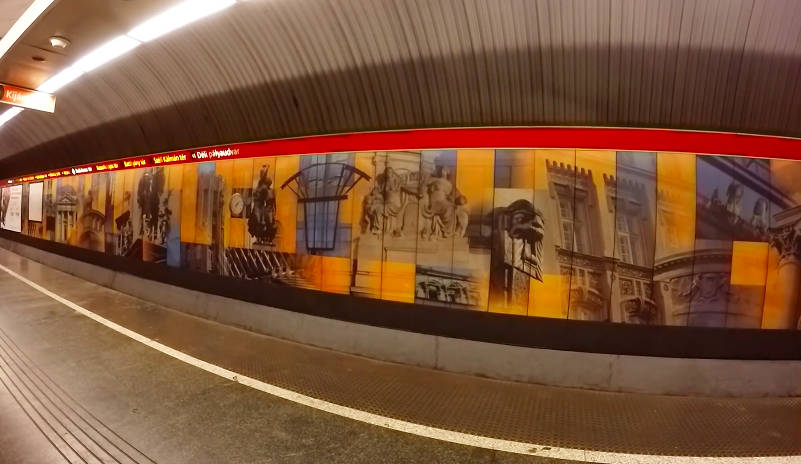
Future expansions
Lines M3 and M4 will be expanded. Additionally, a new line, line M5, will be built.
Line M3 will be expanded with the construction of stations in Káposztásmegyer and in Budapest Ferihegy International Airport.
Line M4 will be expanded with the construction of stations in Gazdagrét, Madárhegy, Bosnyák tér, Dózsa György út (which is not related to the station of the same name in line M3,) Róna utca, Hungária körút, Budaörs, and Újpalota.
The future line M5 will have the following stations: Szentendre, Békásmegyer, Petőfi tér, Rómaifürdő, Csillaghegy, Záhony u., Aquincum, Bogdáni út, Kaszásdúlő, Amfiteátrum , Flórián tér, Soroksár-Hősök tere, Soroksár felső, Millenium-Telep., Szent István u., Margitsziget, Szépvölgy út, Lehel tér, Szent István Park, Klauzál tér, Oktogon, Kálvin tér, Astoria, Könyves Kálmán Körút, Borárus tér, Kén u., Beöthy u., Határ ut, Timót u., Pesterzsébet-városközpont, Klapka Gy. u., Nagysándor József u., Vörösmarty tér, Wesselényi u., Tárcsás u., Könyves u., BILK (logisztickai központ), Soroksári vasúltállomás, Csepel, Ráckeve
Nearby attractions
The Kóbánya-Kispest station will be used as a reference point. To go from Kóbánya-Kispest to the closest touristic attractions, follow these instructions:
1) Museum of Fine Arts : The trip lasts 37 minutes. From Kóbánya-Kispest, board the metro in line M3 towards Újpest-Központ M, and travel for 17 minutes. After 10 stops, get off at Deák Ferenc tér. Next, board the metro in line M1 towards Mexikói út M, and travel for 8 minutes. After 7 stops, get off at Hósök tere. Finally, walk 660 feet, towards 1146 Budapest, Dózsa György út 41.
2) Parliament Buildings : The trip lasts 34 minutes. From Kóbánya-Kispest, board the metro in line M3 towards Újpest-Központ M, and travel for 19 minutes. After 11 stops, get off at Arany János utca. Finally, walk 3200 feet to 1055 Budapest, Kossuth Lajos tér 1-3.
3) Matthias Church : The trip lasts 40 minutes. From Kóbánya-Kispest, board the metro in line M3 towards Újpest-Központ M, and travel for 17 minutes. After 10 stops, get off at Deák Ferenc tér. Then, board the metro in line M2 towards Déli pályaudvar M, and travel for four minutes. After two stops, get off at Széll Kálmán tér. Next, board bus 116 towards Disz térm and travel for four minutes. After four stops, get off at Szentháromság tér. Finally, walk 200 feet towards Mátyás Templom, Budapest, 1014 Magyarország.
4) Margitsziget : The trip lasts 53 minutes. From Kóbánya-Kispest, board the metro in line M3 towards Újpest-Központ, and travel for 25 minutes. After 15 stops, get off at Árpad híd. Next, board bus 106 towards Római úti Itp., Vara utca, and travel for three minutes. After three stops, get off at Margitsziget/Árpad híd. Finally, walk 4600 feet to Margitsziget, 1138 Budapest.
5) Gül Baba Türbéje : The trip lasts 36 minutes. From Kóbánya-Kispest, board the metro in line M3 towards Újpest-Központ, and travel for 20 minutes. After 12 stops, get off at Nyugati pályaudvar. Then, board bus 91 towards Széll Kálmán tér, and travel for five minutes. After two stops, get off at Margit híd, budai hídfó H. Finally, walk 1100 feet to Gül Baba Türbe és Rózsakert Budapest, 1023 Budapest, Mecset utca 14.
Connections
The Budapest Metro makes connections to buses, trams, the trains from the Hungarian State Railways (MÁV,) boats, trolley buses, and the rapid transit and commuter rail service (BHÉV.) The connections available at each station are the following:
- 1) Vörösmarty tér: tram 2, and buses 15 and 115.
- 2) Bajcsy-Zsilinszky út: buses 9 and 105.
- 3) Deák Ferenc tér: lines M2 and M3; trams 47 through 49; and buses 9, 15, among other buses.
- 4) Oktogon: trams 4 and 6, and bus 105.
- 5) Opera: trolley buses 70 and 78, and bus 105.
- 6) Kodály Körönd: bus 105.
- 7) Vörösmarty utca: trolley buses 73 and 76, and bus 105.
- 8) Hósök tere: trolley buses 72, 75, 79; and buses 20E, 30, among other buses.
- 9) Bajza utca: bus 105.
- 10) Széchenyi fürdó: trolley bus 72.
- 11) Mexikói út: trams 1, 3, 6, and 9; trolley buses 74 and 74A; and buses 25, 32, among others.
- 1) Örs Vezér tere: lines 8 and 9 from BHÉV; trams 3, 62, and 62A; trolley buses 80 through 82; and buses 31, 484, among other buses.
- 2) Puskás Ferenc Stadion: tram 1; trolley buses 75, 77, 80, and 80A; and buses 95, 130, among others.
- 3) Pillangó utca: bus 100.
- 4) Blaha Lujza tér: trams 4, 6, 28, 28A, 37, 37A, and 62; trolley bus 74; and buses 5, 7, among other buses.
- 5) Keleti pályaudvar: line M4; tram 24; trolley buses 73, 76, 78 through 80, and 80A; MÁV trains, and buses 5, 7, among other buses.
- 6) Astoria: trams 47, 47B, 48, and 49; trolley bus 74, and buses 9, 15, among other buses.
- 7) Batthyány tér: line 5 from BHÉV, trams 19 and 41, boats 11 and 12, and buses 11, 39, among other buses.
- 8) Széll Kálmán tér: trams 4, 6, 17, 56, 56A, 59, 59A, 59B, and 61; and buses 5, 16, among other buses.
- 9) Kossuth Lajos tér: tram 2; trolley buses 70 and 78; boats 11 and 12; and buses 15 and 115.
- 10) Déli pályaudvar: trams 17, 56, 56A, 59, 59A, 59B, and 61; MÁV trains; and buses 21, 39, among other buses.
- 1) Kóbánya-Kispest: MÁV trains; buses 68, 2000, among other buses.
- 2) Határ út: trams 42, 50, and 52; and buses 66, 89E, among other buses.
- 3) Népliget: tram 1; and buses 254E, 626, among other buses.
- 4) Ecseri út: tram 3; and buses 181 and 281.
- 5) Nagyvárad tér: tram 24, and bus 281.
- 6) Kálvin tér: line M4; trams 47, 47B, 48, 49; trolley bus 83, and buses 9, 15, and 115.
- 7) Corvin-negyed: trams 4 and 6.
- 8) Ferenciek tere: buses 5, 7 and 8.
- 9) Nyugati pályaudvar: trams 4 and 6; trolley buses 72 and 73; MÁV trains, and buses 9, 26, among other buses.
- 10) Arany János utca: trolley buses 72 and 73; and buses 9, 15, and 115.
- 11) Dózsa György út: trolley buses 75 and 79.
- 12) Lehel tér: tram 14, trolley bus 76; and buses 15 and 115.
- 13) Forgách utca: bus 32.
- 14) Árpad híd: tram 1; bus 26, 800, among other buses.
- 15) Újpest-Városkapu: boat 11, MÁV trains, buses 104, 300, among other buses.
- 16) Gyöngyösi utca: buses 15 and 105, and boats 11 through 13.
- 17) Újpest-Központ: trams 12 and 14; and buses 25, 30, among others.
- 1) Kelenföld Vasútállomás: MÁV trains; trams 19 and 49; and buses 8E, 689, among other buses.
- 2) Újbuda-Központ: trams 4, 17, 41, 47, 47B, 48, and 56; and buses 33, 1251, among other buses.
- 3) Bikás park: buses 7, 689, among other buses.
- 4) Szent Gellért tér: trams 19, 41, among other trams; buses 7 and 133E; and boats 11 and 12.
- 5) Móricz Zsigmond Körtér: trams 6, 17, among other trams; buses 7, 27, among other buses.
- 6) Kálvin tér: line M3; trams 47, 47B, among other trams; trolley bus 83; and buses 9, 15, and 115.
- 7) Fóvám tér: trams 2, 47, among other trams; trolley bus 83; and buses 15 and 115.
- 8) II. János Pál pápa tér: trams 28, 28A, among other trams; buses 99 and 217E.
- 9) Rákóczi tér: trams 4 and 6.
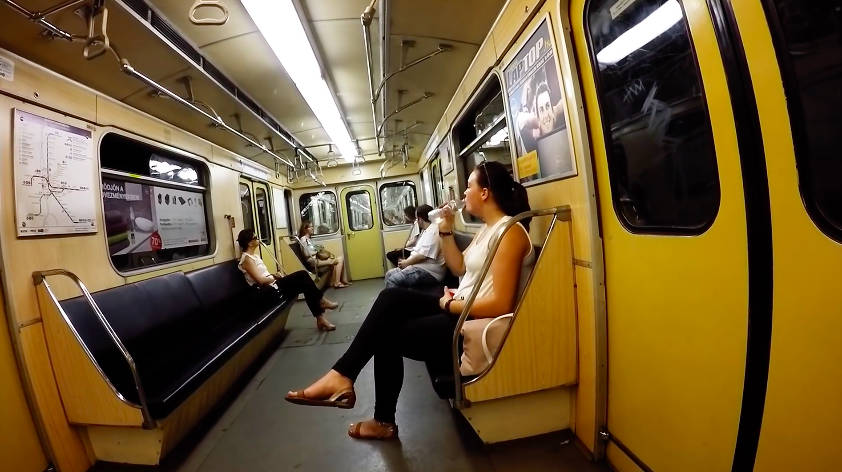
Schedule, calendar, and timetables
Schedules are divided into the following categories: Academic Term, Friday Academic Term, Holiday Academic Term, Holiday Academic Term on Fridays, Saturdays, Sundays and Holidays, Cemetery Schedule, Advent Schedule, December 24, and End of Year. The dates for each schedule during 2017 are the following:
- - Academic Term: Monday through Thursday during most of the year.
- - Friday Academic Term: Most Fridays.
- - Holiday Academic Term: January 2nd, April 18th, June 19th to the 22nd and 26th to the 29th; Monday through Thursday during all of July and August; October 30th and 31st; November 2nd; and December 21st.
- - Saturday: Most Saturdays.
- - Sundays and Holidays: Most Sundays; March 15th; April 14th and 17th; May 1st; June 5th; October 23th; and December 25th and 26th.
- - Cemetery Schedule: October 28th to the 31st and November 1st.
- - Advent Schedule: December 2nd, 3rd, 9th, 10th, 16th, 17th, and 23rd.
- - December 24th: During this day, the metro only runs until 4:00 pm. If you need transportation after that, use night transportation.
- - End of the Year: December 27th through the 29th.
The departure frequencies for each line are the following:
- a) Monday through Friday: 10 minutes during mornings, two to five minutes during the day, and 10 minutes during nights.
- b) Saturdays: 10 minutes during mornings, three to five minutes during the day, and 10 minutes during nights.
- c) Holidays: 10 minutes during mornings, three to five minutes during the day, and 10 minutes during nights.
2) Line M2: 10 minutes during mornings, five minutes during the day, and 10 minutes during nights.
- a) Monday through Friday: 10 minutes during mornings, three to five minutes during the day, and 10 minutes during nights.
- b) Saturdays and public holidays: 10 minutes during mornings, five minutes during the day, and 10 minutes during nights.
- b) Saturdays and holidays: 10 minutes during mornings, five minutes during the day, and 10 minutes during nights.
- Timetables: The opening and closing times for each station are the following (the following format shows the name of the station, the opening time, and the closing time):
- 1) Vörösmarty tér: This is the end of the line, so it has no departure times.
- 2) Bajcsy-Zsilinszky út: 4:42 am - 11:42 pm.
- 3) Deák Ferenc tér: 4:43 am - 11:43 pm.
- 4) Oktogon: 4:39 am - 11:39 pm.
- 5) Opera: 4:41 am - 11:41 pm.
- 6) Kodály Körönd: 4:37 am - 11:37 pm.
- 7) Vörösmarty utca: 4:38 am - 11:38 pm.
- 8) Hósök tere: 4:35 am - 11:35 pm.
- 9) Bajza utca: 4:36 am - 11:36 pm.
- 10) Széchenyi fürdó: 4:34 am - 11:34 pm.
- 11) Mexikói út: 4:32 am - 11:32 pm.
- 1) Örs Vezér tere: 4:27 am - 11:27 pm.
- 2) Puskás Ferenc Stadion: 4:32 am - 11:32 pm.
- 3) Pillangó utca: 4:30 am - 11:30 pm.
- 4) Blaha Lujza tér: 4:37 am - 11:37 pm.
- 5) Keleti pályaudvar: 4:35 am - 11:35 pm.
- 6) Deák Ferenc tér: 4:40 am - 11:40 pm.
- 7) Astoria: 4:38 am - 11:38 pm.
- 8) Batthyány tér: 4:43 am - 11:43 pm.
- 9) Széll Kálmán tér: 4:45 am - 11:45 pm.
- 10) Kossuth Lajos tér: Currently on maintenance.
- 11) Déli pályaudvar: No departures since it is the end of the line.
- 1) Kóbánya-Kispest: 4:26 am - 11:26 pm.
- 2) Pöttyös utca: 4:30 am - 11:30 pm.
- 3) Határ út: 4:29 am - 11:29 pm.
- 4) Népliget: 4:33 am - 11:33 pm.
- 5) Ecseri út: 4:32 am - 11:32 pm.
- 6) Klinikák: 4:37 am - 11:37 pm.
- 7) Nagyvárad tér: 4:35 am - 11:35 pm.
- 8) Kálvin tér: 4:40 am - 11:40 pm.
- 9) Corvin-negyed: 4:38 am - 11:38 pm.
- 10) Deák Ferenc tér: 4:43 am - 11:43 pm.
- 11) Ferenciek tere: 4:41 am - 11:41 pm.
- 12) Nyugati pályaudvar: 4:46 am - 11:46 pm.
- 13) Arany János utca: 4:45 am - 11:45 pm.
- 14) Dózsa György út: 4:49 am - 11:49 pm.
- 15) Lehel tér: 4:48 am - 11:48 pm.
- 16) Forgách utca: 4:53 am - 11:53 pm.
- 17) Árpad híd: 4:51 am - 11:51 pm.
- 18) Újpest-Városkapu: 4:57 am - 11:57 pm.
- 19) Gyöngyösi utca: 4:55 am - 11:55 pm.
- 20) Újpest-Központ: No departures since this is the end of the line.
- 1) Kelenföld Vasútállomás: 4:27 am - 11:27 pm.
- 2) Újbuda-Központ: 4:30 am - 11:30 pm.
- 3) Bikás park: 4:28 am - 11:28 pm.
- 4) Szent Gellért tér: 4:33 am - 11:33 pm.
- 5) Móricz Zsigmond Körtér: 4:32 am - 11:32 pm.
- 6) Kálvin tér: 4:36 am - 11:36 pm.
- 7) Fóvám tér: 4:35 am - 11:35 pm.
- 8) II. János Pál pápa tér: 4:39 am - 11:39 pm.
- 9) Rákóczi tér: 4:38 am - 11:38 pm.
- 10) Keleti pályaudvar: No departures since this is the end of the line.
Metro map of Budapest
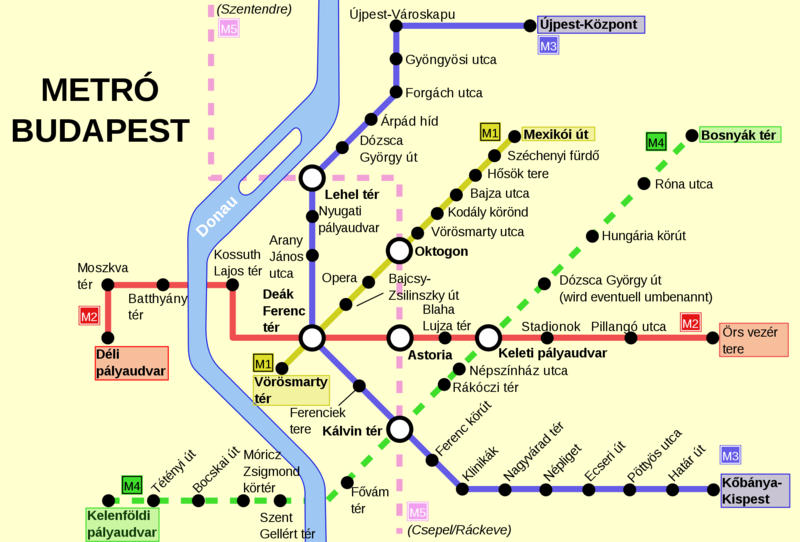
Budapest metro map
- Passengers/Day 1270000
- Fares: 0.95 EUR (2009); honour system
- 24h operation: No
- Air Conditioning: No
- Walk between platforms: No
- Driverless trains: No
- Screen Doors Platforms: No
- Operator: BKV
- M-D H :4.30 -23.30
- Budapest Metro Official Website
- Tlf: +36 1 3 255 255

If you consider that the information we provide is wrong, not accurated, outdated, translation contains errors, and you would like to help us to improve the file...you can contact us here .
Feel free to contact us if you dont find the system you're looking for and we'll add it as soon as we can!
Thank you very much!
[email protected] | Copyright 2023
Privacy Policy | Cookie Policy | **Credits

IMAGES
VIDEO
COMMENTS
Within the administrative boundaries of Budapest for almost all BKK services and suburban buses (lines 1-99, 101-299, 900-999, M1, M2, M3, M4, D14), on HÉV suburban railway lines H5, H6, H7, H8, H9, as well as on trains of MÁV-START in 2nd class (except on trains with supplementary charges, but if the journey is only within Budapest, you can ...
The Budapest Travel Card validation process depends on the purchasing method. For mobile tickets: When you get on the metro or a bus, use the BudapestGO app to scan the QR code or tap your phone on the NFC sticker near the entrance. Once scanned, show the moving image to the staff or, if needed, click on the ticket details to display the code.
Price: : 2 500 HUF - Please note that is not the same as the 24-hour Budapest Card. Valid on all public transport vehicles except for the boat service on the Danube. For an unlimited number of trips from 0:00 to 24:00 of the day indicated on the ticket (you decide on the starting time). 24-Hour Travel Card.
I only travel within Budapest. I travel in the metropolitan area. Adult. Student/pupil. Pensioner. Other. Most popular tickets - valid for one ride. Single ticket. 450 Ft. ... Budapest Card for 96 hours. 32 990 Ft. Read more. Budapest Card for 120 hours. 36 990 Ft. Read more. Pupil group travelcard. 650 Ft. Read more. Airport bus extension ...
Valid on BKK's services as well as on regional bus lines and on suburban railways free and for unlimited travel within the administrative boundaries of Budapest (on lines 1-99, 101-299, 900-999, M1, M2, M3, M4, H5, H6, H7, H8, H9 as well as on boat line D14) and it is also accepted for one free roundtrip ride on the Chairlift in the Zugliget ...
Understand the difference between the Budapest Card, also called the official City Pass, and the Budapest Travel Card.
Types of Budapest Passes, Price, Buying Info. The Budapest Card is a nifty little travel pass available for 5 durations that can make your exploration of this stunning city a whole lot easier and more cost-effective.. With the Budapest Card in your pocket, you'll have unlimited access to public transportation, like buses, trams, and the 4 metro lines.
The Budapest Card (don't be surprised to hear it called the City Pass) is the official travel card of Budapest. With it, you get unlimited public transportation. But that's not everything: you'll also get airport transfer, free entrance in some of the most important museums (like in the Buda Castle 's), 20% discount at Széchenyi ...
The Budapest Card is the official city travel card of Budapest, Hungary's Capital city and allows travelers to enjoy the following perks free of charge: ... Travel on buses, trams and metro; Visit 7 museums (including Hungarian National Museum and Budapest History Museum) Relax in St. Lukács Medicinal Baths and Swimming Pool (and receive ...
The cost of the Budapest 7 Day Travel Card depends on the type of card you choose. Currently, the prices are as follows: Card Type. Price (HUF) Adult. 4950. Child (up to 14 years old) 2475. Please note that prices are subject to change, so it's recommended to check the latest pricing information before your trip.
24-hour Group Travelcard: 3,300 HUF ($11.70) 7 Day Travelcard: 4,950 HUF ($17.70) If you're in a group of 3 or more, the group Travelcard is a great deal. Each group card can be used for up to 5 people. The only downfall is that you'll have to buy a new 24 hour card each day of the trip. If you'll be in Budapest more than 3 days, the 7 ...
The Budapest public transportation card is exactly what you need! 3 days of unlimited public transportation (metro, bus and tram) in the city plus a private airport transfer from Budapest Ferenc Liszt airport. Perfect to get to know the city and start your citytrip in a relaxed way! ... Budapest Travel Card. Transport card: €10,00. Book now ...
Fares: Single tickets cost 350 Hungarian forints and you can change metro lines with a single ticket. Travel passes are also available for 24 hours (1,650 forints), 72 hours (4,150 forints), or a week (4,950 forints), which cover all modes of transportation. If you get a Budapest Card, you can have unlimited transport for the period you choose ...
Budapest Pay&GO: you can buy and validate your ticket at the same time with your bankcard on the 100E Airport Express and on metro line M1. Validate your ticket at the start of your trip! To use the red coloured manual validator, insert the ticket into the slot and pull the handle towards you until the ticket is punched.
TIP: Free Travel with the City Card. With a Budapest card you can travel on the city's public transport services free of charge. The card also entitles you to discount admission to a wide range off sights and attractions in Budapest (museums, baths, monuments etc.). For a 2-3 day or longer visit it's worth buying. You have a choice to ...
Budapest Metro opens every day at 4:30 am and runs until 11 pm. The trains pass every 2 to 15 minutes depending on the time of day. Tariffs. BKK, Budapest's public transport company issues the same tickets and travel passes for all of the city's transport system. Moreover, transport in Hungary's capital always costs the same.
In 2024,All the famous monuments within the city of Budapest can be reached with public transportation covered by 24 hour Budapest pass. M1,M2,M3, and M4 can take you to any famous monument within 30 mins, and these are covered in a 24 hr ticket. You can explore the majority of the city with tram 6-4,47,48,49 also covered in the 24 hr ticket.
Metro Section Ticket: €0.85. Block of 10 Tickets: €8.50. Learn more about these ticket types. Alternatively, you could save avoid the potential hassle of figuring out the # and type of tickets you need and by purchasing a travel card instead.
There is a TravelCard which is a public transportation only card. It is fairly cheap and goes up to hourly limits Then to confuse matters they switch names to Budapest Pass for the 15 day and longer cards. There is a Budapest Card which is tourist card for public transportation and discounts on lots of other things. Its a bit expensive. This page explains all the shorter term cards https://bkk ...
9. Re: Metro travelcard or pass. 1 year ago. Yes it's definitely better to get an unlimited public transport pass that covers the period you'll be in Budapest for. There's also an app you can download for purchasing tickets, that way you simply have your valid ticket on your phone.
The Budapest Metro is a prominent transport system in the city, serving a significant number of passengers, approximately 1,270,000 per day. In 2009, the fare for a single journey was €0.95 and it operates on an honour system. ... Budapest Card: This offers unlimited travel on all transport networks, free or discounted entry to many ...
The metro does not go directly to the Budapest Franz Liszt International Airport. The closest metro station is Kóbánya-Kispest in line M3. To go from the Franz Liszt airport to this station, board bus 200E, and travel for around half an hour. Prices, Tickets, and Cards for the Budapest Metro